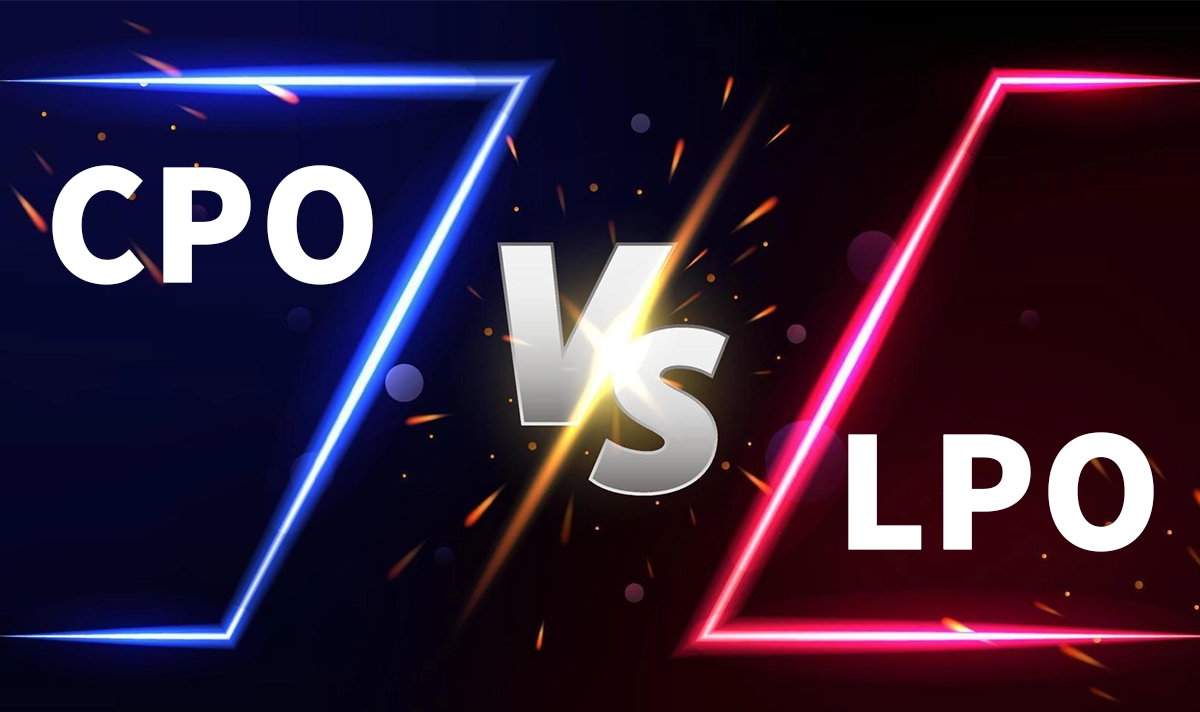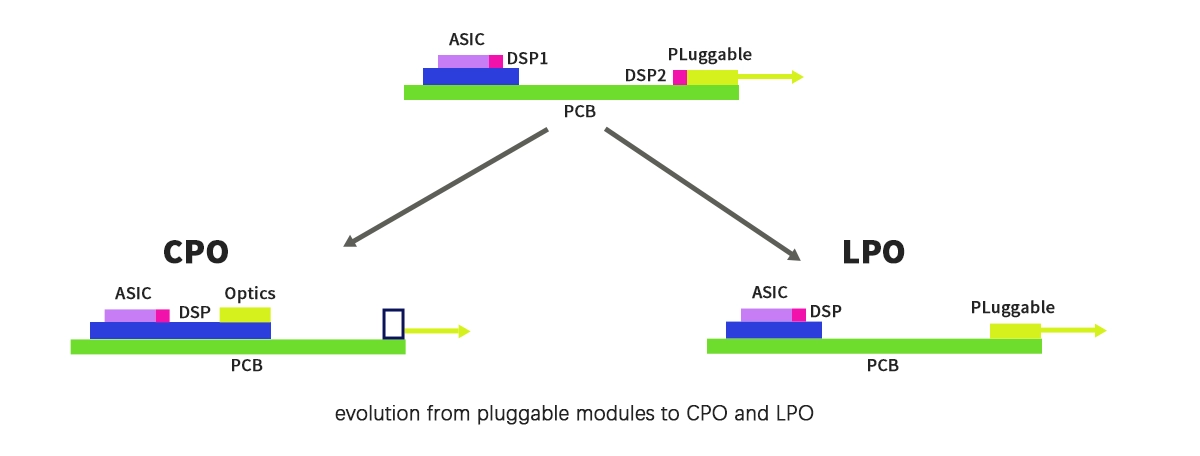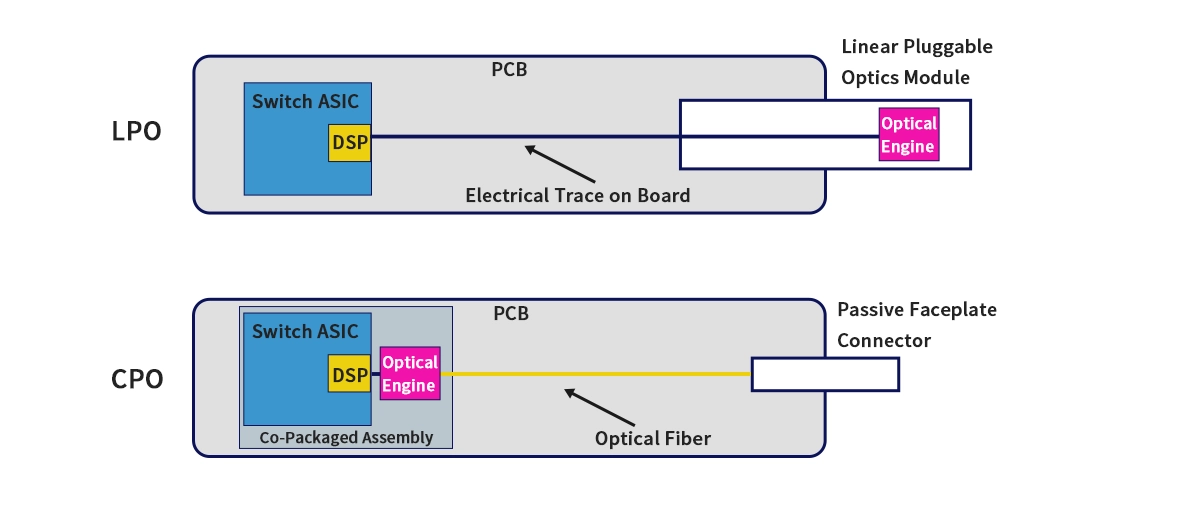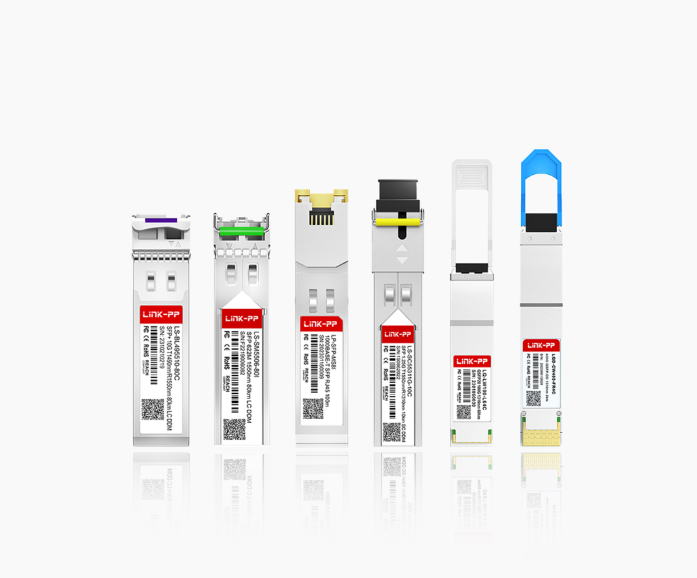
The relentless demand for higher bandwidth, lower latency, and improved power efficiency in hyperscale data centers and AI/ML clusters is pushing optical interconnect technology to its limits. Traditional pluggable optics with sophisticated DSPs face challenges in power consumption and cost at 800G and beyond. Enter two contenders vying to address these challenges: Co-Packaged Optics (CPO) and Linear Pluggable Optics (LPO). Understanding their differences is crucial for making informed infrastructure decisions.
▶ Understanding the Core Challenge: Power and Complexity
Pluggable optical transceivers (like QSFP-DD and OSFP) have been the backbone of data center networks. However, as speeds reach 800G and target 1.6T, the Digital Signal Processor (DSP) inside these modules becomes a significant bottleneck:
High Power Consumption: DSPs consume substantial power for signal conditioning (compensation, error correction).
Increased Latency: DSP processing adds nanoseconds of latency.
Cost: Advanced DSP chips are expensive and add complexity.
Thermal Management: Dissipating DSP heat within a small module footprint is challenging.
CPO and LPO represent divergent evolutionary paths to overcome these limitations.

▶ Co-Packaged Optics (CPO): Deep Integration
CPO fundamentally changes the architecture by moving the optical engine off the pluggable module and onto the same substrate or package as the host switch Application-Specific Integrated Circuit (ASIC). The optics and electronics are "co-packaged."
How it Works: The optical engine sits extremely close to the ASIC die. Electrical signals travel very short distances over optimized channels (like Silicon Interposers). This eliminates the need for complex, power-hungry DSPs within the optical engine itself, as signal integrity challenges are minimized by the ultra-short reach.
Key Advantages:
Significantly Lower Power: Removes DSP power and optimizes the entire electrical path.
Higher Density: Enables more ports per switch faceplate.
Potential Bandwidth Density: Allows tighter integration for massive bandwidth.
Reduced System Latency: Shorter electrical paths and no DSP processing delay.
Key Challenges:
Complexity & Cost: Requires radical redesign of switch ASIC packages, complex co-design of optics and electronics, and advanced manufacturing (like silicon photonics). Very high non-recurring engineering costs.
Thermal Management: Integrating high-power ASICs and optics demands sophisticated cooling solutions.
Supply Chain: Creates a single-vendor lock-in for the switch/ASIC/optics combination.
Field Serviceability: Replacing optics requires pulling the entire switch board, increasing operational expenditure and downtime risk. No independent optics upgrades.
Maturity: Still primarily in the pre-commercial/pre-standardization phase. Limited ecosystem support.
▶ Linear Pluggable Optics (LPO): Simplified Pluggability
LPO, sometimes called "Linear Drive" or "Direct Drive," takes a different approach. It retains the familiar, valuable pluggable form factor but dramatically simplifies the optics by removing the DSP entirely.
How it Works: LPO modules rely on "linear" or "analog drive" components (high-performance linear TIAs and drivers) instead of a DSP. They depend on the host switch ASIC having sufficiently powerful analog front-end circuitry and advanced signal processing capabilities to compensate for channel impairments on the host side. This shifts the signal integrity burden from the pluggable module to the switch.
Key Advantages:
Lower Power per Module: Eliminating the DSP reduces module power consumption by ~50% compared to DSP-based equivalents.
Lower Latency: Removes DSP processing latency within the module.
Lower Module Cost: Removes the expensive DSP chip.
Reduced Module Heat: Easier thermal management within the pluggable cage.
Pluggability & Flexibility: Maintains the critical benefits of pluggable optics – field serviceability, independent upgrades, multi-source agreements, and flexibility in network design. Compatible with existing form factors (QSFP-DD, OSFP).
Maturity & Availability: Technology is available now (e.g., 400G, 800G). Early adoption is underway.
Key Challenges:
Host Dependency: Requires switch ASICs specifically designed with robust linear analog front-ends and potentially enhanced DSP/FEC capabilities.
Reach Limitations: Primarily targets very short reaches within racks (SR) or between adjacent racks (DR) – typically 100m to 500m for multi-mode fiber and up to 2km for single-mode fiber. Not suitable for long-haul.
Link Performance: May have slightly higher bit error rates than DSP-based solutions, relying heavily on strong Forward Error Correction (FEC). Requires tight ASIC-to-module co-design.
▶ CPO vs LPO: A Direct Comparison

Feature | Co-Packaged Optics (CPO) | Linear Pluggable Optics (LPO) |
|---|---|---|
Architecture | Optics integrated with ASIC on package/board | DSP-less Pluggable Module |
Power Consumption | Lowest (System level optimization) | Lower than DSP-based modules (~50% less) |
Latency | Lowest (shortest paths) | Lower than DSP-based (No module DSP) |
Module Cost | N/A (Not separate) | Lower (No DSP chip) |
System Cost | Very High (Redesign, complex packaging) | Moderate (Leverages pluggable ecosystem) |
Density | Highest Potential | Similar to Standard Pluggables |
Reach | Ultra-Short Reach (cm) | Short Reach (SR: ~100m, DR: ~500m-2km) |
Field Serviceability | Very Difficult (Replace entire board) | Easy (Hot-swappable modules) |
Vendor Flexibility | Lock-in (Single vendor solution) | High (Pluggable MSA ecosystem) |
Upgrade Path | Difficult (Requires new system) | Easy (Swap modules) |
Thermal Challenge | High (Integrated ASIC + Optics) | Lower (Heat spread across module + switch) |
Maturity | Emerging (Pre-commercial/R&D) | Available Now (400G, 800G shipping) |
Best Suited For | Future AI/ML Clusters, Largest Hyperscalers | Top-of-Rack, Intra-Rack, Short-Reach Spine-Leaf |
▶ Where Do LINK-PP and Optical Transceivers Fit In?
For data center operators and network architects needing high-performance, cost-effective, and low-power optical transceiver solutions today and in the near term, LPO presents a compelling, practical choice. LINK-PP is at the forefront of developing reliable LPO technology, offering tangible benefits now.
LPO Solutions Available: LINK-PP provides high-quality linear drive pluggable optics, like our 800G-LPO series, designed for compatibility with leading switch platforms featuring LPO-ready host ASICs. These modules deliver the promised power and latency savings while maintaining the crucial pluggability operators require. Explore our range of low latency optical modules designed for next-gen AI networking.
The Pluggable Advantage: Choosing LINK-PP LPO optical transceivers means maintaining flexibility. You can deploy them in specific high-density, power-sensitive areas like AI/ML server clusters or high-frequency trading networks without overhauling your entire infrastructure. Need to upgrade or replace a module? It's simple. Looking for low power consumption optical solutions for your rack endpoints? LPO delivers.
Future-Proofing with Pluggability: While CPO holds long-term promise for specific ultra-high-density applications, the pluggable model, championed by LPO, ensures investment protection, multi-vendor choice, and easier technology migration paths. LINK-PP remains committed to advancing high speed pluggable transceiver technology like LPO to meet evolving demands.
▶ Choosing Between CPO and LPO: Key Considerations
Your decision hinges on specific needs:
Timeline & Urgency: Need solutions now for 800G/1.6T deployments? LPO is the only viable, shipping option. CPO is years away from mainstream adoption.
Power Reduction Scope: If your absolute priority is minimizing power at any cost and complexity, and you operate at the largest scale, CPO's potential is significant. For substantial power savings per module with lower system complexity, LPO wins.
Operational Flexibility: Require field serviceability, multi-source options, and incremental upgrades? LPO's pluggability is essential. CPO sacrifices this for integration.
Reach Requirements: For links beyond ~2km, DSP-based pluggables remain necessary. LPO is purpose-built for intra-data-center short reaches. CPO is inherently ultra-short reach.
Budget & Risk Tolerance: LPO leverages existing infrastructure and supply chains, offering lower risk and cost. CPO requires massive R&D investment and carries significant technical and financial risk.
▶ Conclusion: LPO - The Pragmatic Path Forward for High-Speed Optical Transceivers
The CPO vs LPO debate isn't about one technology "winning" outright. It's about choosing the right tool for specific challenges and timelines.
CPO represents a radical, long-term architectural shift with high potential but equally high complexity, cost, and risk. It's a future vision for the most demanding, specialized applications.
LPO offers a revolutionary yet pragmatic evolution of pluggable optical transceivers. By intelligently removing the DSP and leveraging host ASIC capabilities, it delivers significant power and latency savings today while preserving the critical operational and financial benefits of pluggability that define modern data center networks. LINK-PP LPO solutions, such as our LQD-M85400-SR4C and LQD-M31800-DR8C modules, provide a clear, low-risk path to more efficient, high-performance connectivity for AI/ML, HPC, and high-density enterprise cores.
For most organizations navigating the transition to 800G and 1.6T, LPO provides the optimal blend of performance, power efficiency, cost-effectiveness, and operational flexibility available right now.
Ready to explore how low-power, low-latency LPO optical transceivers can optimize your data center network?
▶ See Also
Understanding The Basics Of Common Public Radio Interface
Essential Information About Power Over Ethernet Technology




